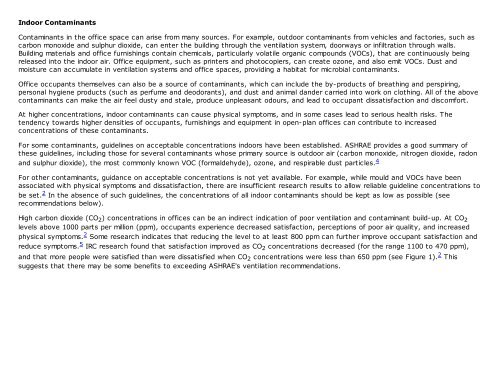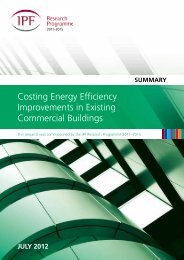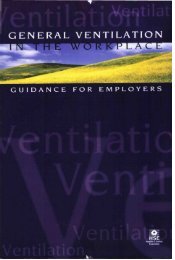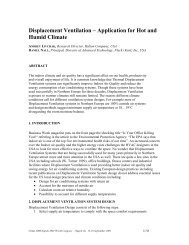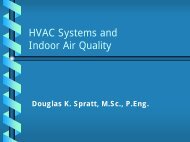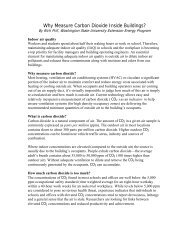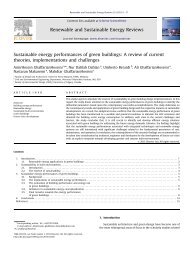Indoor Air Quality and Thermal Comfort in Open-Plan Offices
Indoor Air Quality and Thermal Comfort in Open-Plan Offices
Indoor Air Quality and Thermal Comfort in Open-Plan Offices
You also want an ePaper? Increase the reach of your titles
YUMPU automatically turns print PDFs into web optimized ePapers that Google loves.
<strong>Indoor</strong> Contam<strong>in</strong>antsContam<strong>in</strong>ants <strong>in</strong> the office space can arise from many sources. For example, outdoor contam<strong>in</strong>ants from vehicles <strong>and</strong> factories, such ascarbon monoxide <strong>and</strong> sulphur dioxide, can enter the build<strong>in</strong>g through the ventilation system, doorways or <strong>in</strong>filtration through walls.Build<strong>in</strong>g materials <strong>and</strong> office furnish<strong>in</strong>gs conta<strong>in</strong> chemicals, particularly volatile organic compounds (VOCs), that are cont<strong>in</strong>uously be<strong>in</strong>greleased <strong>in</strong>to the <strong>in</strong>door air. Office equipment, such as pr<strong>in</strong>ters <strong>and</strong> photocopiers, can create ozone, <strong>and</strong> also emit VOCs. Dust <strong>and</strong>moisture can accumulate <strong>in</strong> ventilation systems <strong>and</strong> office spaces, provid<strong>in</strong>g a habitat for microbial contam<strong>in</strong>ants.Office occupants themselves can also be a source of contam<strong>in</strong>ants, which can <strong>in</strong>clude the by-products of breath<strong>in</strong>g <strong>and</strong> perspir<strong>in</strong>g,personal hygiene products (such as perfume <strong>and</strong> deodorants), <strong>and</strong> dust <strong>and</strong> animal d<strong>and</strong>er carried <strong>in</strong>to work on cloth<strong>in</strong>g. All of the abovecontam<strong>in</strong>ants can make the air feel dusty <strong>and</strong> stale, produce unpleasant odours, <strong>and</strong> lead to occupant dissatisfaction <strong>and</strong> discomfort.At higher concentrations, <strong>in</strong>door contam<strong>in</strong>ants can cause physical symptoms, <strong>and</strong> <strong>in</strong> some cases lead to serious health risks. Thetendency towards higher densities of occupants, furnish<strong>in</strong>gs <strong>and</strong> equipment <strong>in</strong> open-plan offices can contribute to <strong>in</strong>creasedconcentrations of these contam<strong>in</strong>ants.For some contam<strong>in</strong>ants, guidel<strong>in</strong>es on acceptable concentrations <strong>in</strong>doors have been established. ASHRAE provides a good summary ofthese guidel<strong>in</strong>es, <strong>in</strong>clud<strong>in</strong>g those for several contam<strong>in</strong>ants whose primary source is outdoor air (carbon monoxide, nitrogen dioxide, radon<strong>and</strong> sulphur dioxide), the most commonly known VOC (formaldehyde), ozone, <strong>and</strong> respirable dust particles. 4For other contam<strong>in</strong>ants, guidance on acceptable concentrations is not yet available. For example, while mould <strong>and</strong> VOCs have beenassociated with physical symptoms <strong>and</strong> dissatisfaction, there are <strong>in</strong>sufficient research results to allow reliable guidel<strong>in</strong>e concentrations tobe set. 2 In the absence of such guidel<strong>in</strong>es, the concentrations of all <strong>in</strong>door contam<strong>in</strong>ants should be kept as low as possible (seerecommendations below).High carbon dioxide (CO 2 ) concentrations <strong>in</strong> offices can be an <strong>in</strong>direct <strong>in</strong>dication of poor ventilation <strong>and</strong> contam<strong>in</strong>ant build-up. At CO 2levels above 1000 parts per million (ppm), occupants experience decreased satisfaction, perceptions of poor air quality, <strong>and</strong> <strong>in</strong>creasedphysical symptoms. 2 Some research <strong>in</strong>dicates that reduc<strong>in</strong>g the level to at least 800 ppm can further improve occupant satisfaction <strong>and</strong>reduce symptoms. 5 IRC research found that satisfaction improved as CO 2 concentrations decreased (for the range 1100 to 470 ppm),<strong>and</strong> that more people were satisfied than were dissatisfied when CO 2 concentrations were less than 650 ppm (see Figure 1). 2 Thissuggests that there may be some benefits to exceed<strong>in</strong>g ASHRAE's ventilation recommendations.


